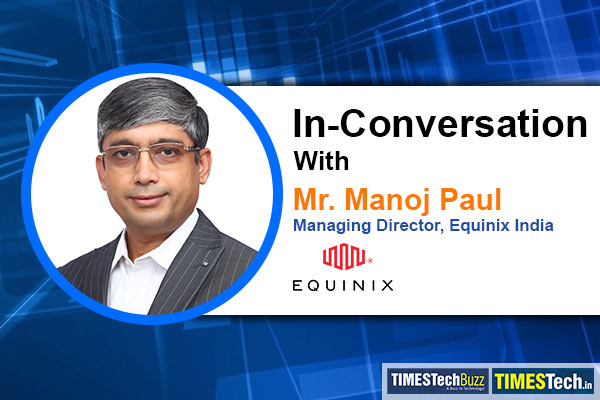In an exclusive interview with TimesTech, Equinix’s Managing Director, Manoj Paul, sheds light on the evolving landscape of digital infrastructure, emphasizing the shift towards subscription-based models and the burgeoning demand for edge infrastructure, particularly in Mumbai, India.
Read the full interview here:
TimesTech: How does the GXI 2024 shift from CAPEX to OPEX for enterprise agility in AI, 5G, and edge computing?
Mr. Manoj: The shift from CAPEX to OPEX started with multi-cloud adoption but is now becoming the norm across all infrastructure out to the edge. It gives enterprises greater agility in architecting their infrastructure everywhere while ensuring access to the most efficient technologies. To meet the ever-growing demands of data-dense technologies such as AI, 5G, and edge computing, IT decision-makers are increasingly shifting away from long-term purchases of physical equipment, such as servers, routers, and storage arrays, in favor of flexible subscription-based models, predicts GXI 2024.
The power of the digital economy is rooted in the ability to exchange high volumes of data. Enterprises must be able to move data from multiple sources to various processing locations while maintaining control and security around that data. Exchanging data via direct interconnection links between enterprises, service providers and content providers makes it more efficient to do this; the fact that global interconnection bandwidth is growing twice the internet rate shows that more and more businesses understand this.
TimesTech: Can you discuss Equinix’s role in India’s digital transformation and expanding ecosystems? How is Equinix positioned for the surge in edge infrastructure growth, especially in Mumbai?
Mr. Manoj: Equinix remains steadfast in its commitment to bolstering India’s burgeoning digital economy, a realm projected to attain the remarkable milestone of $1 trillion by 2026. The ongoing surge in digitalization within the economic landscape incessantly underscores the imperative for cutting-edge data center and interconnection services across India. Equinix aims to empower local and overseas customers in India by providing access to our interconnection platform, facilitating seamless connections to diverse cloud service providers, network services, and other enterprises.
Companies in India are distributing and localizing technology innovation to transform business operations for greater differentiation and this trend is driving businesses at the edge. More service providers are strategically moving closer to users, with nearly half of their locations anticipated to be at the edge. Among these developments, Mumbai emerges as one of the top three fastest-growing edge metros, with a forecasted Compound Annual Growth Rate (CAGR) of 43% over the next five years, according to GXI 2024.
Equinix is uniquely positioned to help organizations as they shift to data-driven decisions because it has the physical resources and connections to support secure data gathering, storage, and analytics at the edge. Equinix operates interconnected data centers in Mumbai – MB1 and MB2. The upcoming MB4 center will further enhance connectivity options, including Metro Connect availability to MB1 and MB2.
TimesTech: What’s driving the forecasted 80% shift to subscription models in enterprise digital infrastructure by 2026?
Mr. Manoj: The forecasted 80% shift to subscription models in enterprise digital infrastructure by 2026 is being driven by several factors, including the need for agility, flexibility, and scalability in a rapidly changing digital landscape, as well as the increasing adoption of cloud, AI, IoT, and edge computing. Subscription models enable enterprises to consume and pay for only the resources they need, when they need them, reducing costs, and increasing efficiency. Cloud adoption is a big part of the service model adoption.
TimesTech: Key drivers behind the 34% CAGR in global interconnection bandwidth to 33,578 Tbps by 2026?
Mr. Manoj: The GXI 2024 highlights the following as drivers of growth in global interconnection bandwidth:
1) Businesses are integrating technology to pivot towards delivering value electronically through digital services. Even fast-followers who don’t have access to digital ecosystems are swiftly adapting by leveraging these ecosystems to forge collaborative value networks with complementary skills. It enables them to rapidly integrate technologies like AI into business processes for efficiency gains.
2) As more business-to-business collaborations transition toward digital ecosystems and marketplaces, each industry is increasing its own forms of electronic exchange. Businesses have realized that without interconnecting with multiple business partners, moving the data around and then processing the exponentially increasing volumes and diverse types of data would be difficult.
3) Regulators’ focus on sustainability is another critical driver, leading more organizations to move this to the forefront. Again, to address this, companies turn to unlocking the collective potential of ecosystems and choosing partners who share their vision. By integrating those goals into the business strategy, organizations can sustainably scale their digital operations.
TimesTech: Regarding real-time action at the edge, how are organizations leveraging digital ecosystems and interconnection?
Mr. Manoj: GXI 2024 forecasts that organizations will continue to increase ecosystem participation significantly as they seek to reduce reliance on owned physical equipment and gain the flexibility of subscription-based models for their digital infrastructure. There’s a constant influx of providers and consumers of services as digital ecosystems continually form across all industries, taking the economy to higher forms of value and collaboration. Businesses are gaining faster time to value by adding services and leveraging skills, capabilities, and innovation to help redesign their business processes and equip them to sell their services to a larger audience. Companies that may have gotten a late start are closing the gap as they tap into digital ecosystems to subscribe to necessary skills and capabilities rather than do it all themselves. Organizations are leveraging analytics and AI insights from data generated in the field for real-time decision-making, helping companies enable innovation that transforms practices from the edge in while IT transforms from the cloud out. With the volume of emerging regulations prioritizing sustainability, companies are turning to ecosystems and choosing partners that share their future-first vision, allowing them to scale digital operations sustainably.















